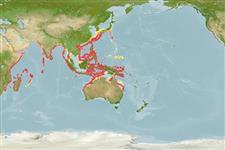>
Carangiformes (Jacks) >
Carangidae (Jacks and pompanos) > Caranginae
Etymology: Decapterus: Greek, deka = ten + Greek, pteron = wing, fin (Ref. 45335).
More on author: Bleeker.
Environment: milieu / climate zone / intervalo de profundidade / distribution range
Ecologia
marinhas associadas(os) a recifes; intervalo de profundidade 100 - 300 m (Ref. 3197), usually 150 - 300 m (Ref. 3197). Deep-water; 38°N - 26°S, 34°E - 148°E
Indo-West Pacific: East Africa to the Philippines, north to southern Japan, south to Western Australia.
Length at first maturity / Tamanho / Peso / Idade
Maturidade: Lm 17.2 range ? - ? cm
Max length : 45.0 cm TL macho/indeterminado; (Ref. 3197); common length : 30.0 cm FL macho/indeterminado; (Ref. 3287)
Espinhos dorsais (total) : 9; Raios dorsais moles (total) : 28 - 29; Espinhos anais: 3; Raios anais moles: 22 - 25. Deep bodied compared to similar species (Ref. 48635). Body color bluish green above, silvery below; caudal fin bright red. Sometimes a yellow mid-lateral stripe (Ref. 48635). Opercle with a small black spot; margin of opercular membrane smooth. 31-38 scutes.
Body shape (shape guide): fusiform / normal; Cross section: compressed.
Adults are found in deep waters. They feed on small planktonic invertebrates (Ref. 5213). Occasionally seen in small groups along reef slopes at moderate depths. Mainly known from trawls and shows red tail after capture (Ref. 48635).
Paxton, J.R., D.F. Hoese, G.R. Allen and J.E. Hanley, 1989. Pisces. Petromyzontidae to Carangidae. Zoological Catalogue of Australia, Vol. 7. Australian Government Publishing Service, Canberra, 665 p. (Ref. 7300)
Categoria na Lista Vermelha da IUCN (Ref. 130435: Version 2025-1)
Ameaça para o homem
Harmless
Utilização humana
Pescarias: espécies comerciais
Ferramentas
Relatórios especiais
Descarregue XML
Fontes da internet
Estimates based on models
Preferred temperature (Ref.
123201): 11.5 - 22.4, mean 15 °C (based on 274 cells).
Phylogenetic diversity index (Ref.
82804): PD
50 = 0.5005 [Uniqueness, from 0.5 = low to 2.0 = high].
Bayesian length-weight: a=0.01318 (0.00891 - 0.01950), b=3.00 (2.88 - 3.12), in cm total length, based on LWR estimates for this species & Genus-body shape (Ref.
93245).
Nível Trófico (Ref.
69278): 3.4 ±0.45 se; based on food items.
Resiliência (Ref.
120179): Médio, tempo mínimo de duplicação da população 1,4 - 4,4 anos (K=0.63).
Fishing Vulnerability (Ref.
59153): Low vulnerability (25 of 100).
🛈
Nutrients (Ref.
124155): Calcium = 58.6 [15.2, 161.2] mg/100g; Iron = 1.09 [0.40, 2.96] mg/100g; Protein = 20.1 [18.6, 21.6] %; Omega3 = 0.31 [0.14, 0.71] g/100g; Selenium = 17.3 [5.0, 56.2] μg/100g; VitaminA = 20.4 [3.5, 129.2] μg/100g; Zinc = 0.478 [0.264, 0.847] mg/100g (wet weight);
